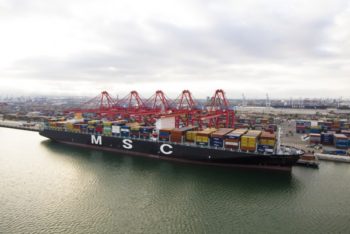The biggest threat facing the recovery in the container shipping market is the large amount of newbuildings set to be delivered this year according to consultants Drewry.
While both freight rates and demand have improved in recent months risks for newbuild tonnage and cascading of older vessels remain.
“We are more optimistic than we have been in a long while as demand will continue to make small, incremental gains and freight rates will rebound after last year’s nadir,” Drewry commented in its weekly report on the container market.
“However, we also identified the biggest risk to that outlook as the huge number of ship deliveries, particularly at the top end of the scale.”
Barring delivery delays container shipping is facing up to 1.7m teu of newbuildings this year, more than half of these over 14,000 teu, meaning the vast majority will be deployed on the Asia – North Europe trade. This means that existing vessels on this trade will be cascaded on other trades such as the transpacific and Asia – Med, and in turn smaller vessels on those trades will need to find new homes or be laid-up. The flood of capacity onto the secondary trades puts improvements in rates at risk.
Giving an example Drewry said: “The appearance of 13,000 teu ships (from MSC) on the Asia to West Africa trade has helped boost the average deployed tonnage by 16% (January 2016 vs December 2016) yet shipments in the southbound leg were down by 11% in the year-to-date as of end-November 2016.”
Meanwhile the Asia – East Coast South America market has seen a 7% increase in a capacity while demand has fallen by 20%.
Drewry commented that while utilisation was up slightly on the East – West trades, consequently boosting rates, the pain was merely being passed along to the North – South trades.
“These trades are the victims of the fact there is simply nowhere else to put the cascaded East-West ships and until they recover the demand strength carriers will either have to accept poor returns on freight rates or park more ships,” the report said.
Copyright Ships & Ports Ltd. Permission to use quotations from this article is granted subject to appropriate credit given to www.shipsandports.com.ng as the source.
